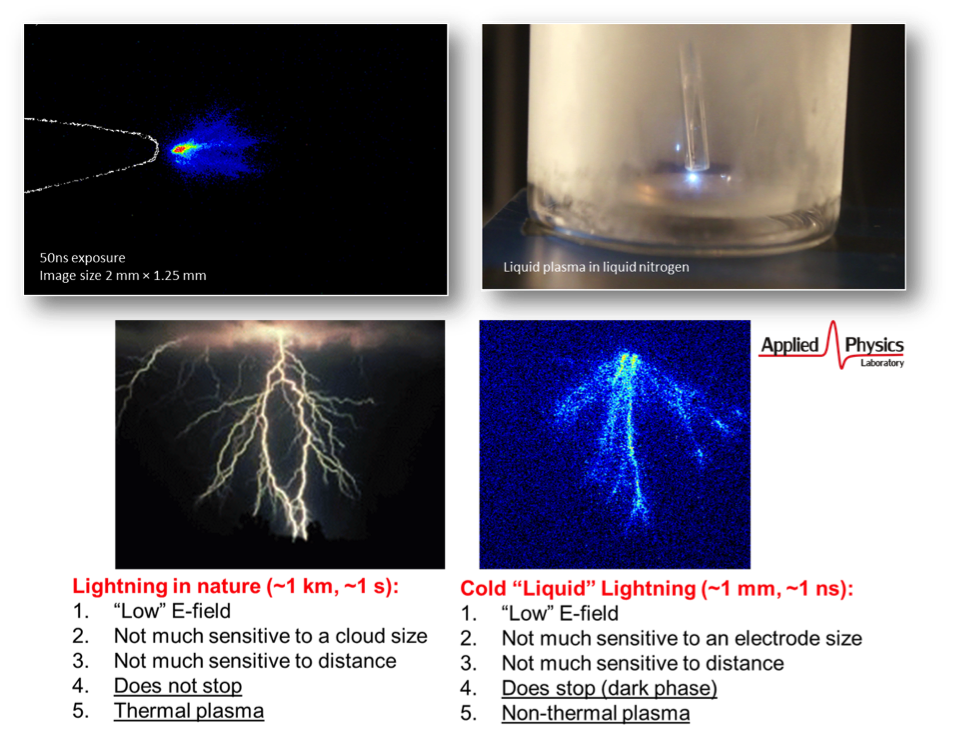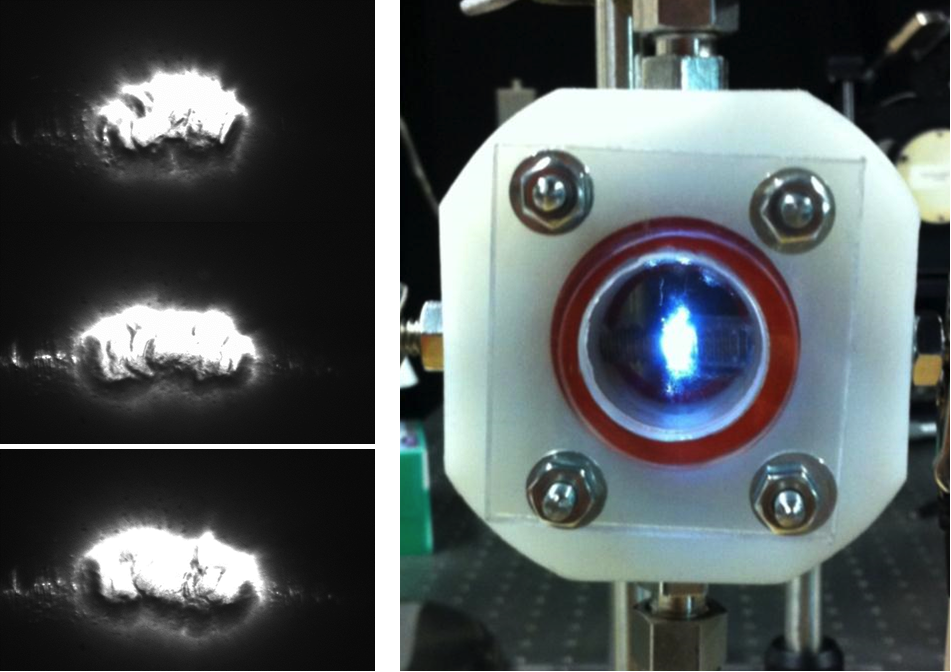Applied Physics Lab
The Applied Physics Laboratory, led by Dr. D. Dobrynin, was formed in 2011, and is focused on the fundamental and applied research of “cold” atmospheric pressure plasmas. Primary research areas include fundamental studies and characterization of nanosecond discharges in both gas and liquid phase, plasma jets, dielectric barrier discharges, sparks and gliding arcs in various configurations, as well as research in the areas of physics and chemistry of plasma catalysis, plasma assisted combustion and ignition, plasma medicine, plasma assisted natural gas-to-liquid conversion, and others.
As an integral part of the C. & J. Nyheim Plasma Institute, APL works closely with Plasma Energy, Plasma Environmental Control, and Plasma Medicine laboratories. APL has and continues to collaborate with respected scientists from Thomas Jefferson University, Drexel's College of Medicine (Biochemistry & Molecular Biology), College of Art and Sciences (Chemistry), College of Engineering (Mechanical Engineering and Mechanics, Electrical Engineering, Chemical Engineering), and NASA Jet Propulsion Laboratory, and others.
 One of the fundamentally new and exciting phenomenon discovered at Drexel is the nanosecond discharge in liquid phase (liquid plasma). Plasma is best known as a gas phase phenomenon. Although efforts have been made in the past several decades to seek plasma in fluid phase, most researchers observed plasma only in low density phase (gas) bubbles and voids dispersed within fluids. Recent advances in pulsed power technology have permitted the application of much faster voltage rise times (including the subnanosecond range) and revealed that a plasma-like phenomena can, in fact, occur in fluid phase quasi-homogeneously without any bubbles and voids. In our studies, we have demonstrated the possibility of a formation of non-equilibrium plasma in the liquid phase. Extensive analytical and experimental studies have shown that the discharge initiation mechanism is determined by the so-called electrostriction phenomenon which causes formation of a region saturated with nanopores providing necessary space for electrons to gain energy leading to the generation of secondary electrons. Expected unique non-equilibrium properties of nanosecond plasma discharge in homogeneous high-density medium, such as high densities of electrons and excited species, light and high energy radiation, and high electron energies together with low temperature of liquid, are associated with exclusive opportunities that may lead to fundamentally new effects and have great impact in the fields of medicine, microelectronics, energy systems, and materials.
One of the fundamentally new and exciting phenomenon discovered at Drexel is the nanosecond discharge in liquid phase (liquid plasma). Plasma is best known as a gas phase phenomenon. Although efforts have been made in the past several decades to seek plasma in fluid phase, most researchers observed plasma only in low density phase (gas) bubbles and voids dispersed within fluids. Recent advances in pulsed power technology have permitted the application of much faster voltage rise times (including the subnanosecond range) and revealed that a plasma-like phenomena can, in fact, occur in fluid phase quasi-homogeneously without any bubbles and voids. In our studies, we have demonstrated the possibility of a formation of non-equilibrium plasma in the liquid phase. Extensive analytical and experimental studies have shown that the discharge initiation mechanism is determined by the so-called electrostriction phenomenon which causes formation of a region saturated with nanopores providing necessary space for electrons to gain energy leading to the generation of secondary electrons. Expected unique non-equilibrium properties of nanosecond plasma discharge in homogeneous high-density medium, such as high densities of electrons and excited species, light and high energy radiation, and high electron energies together with low temperature of liquid, are associated with exclusive opportunities that may lead to fundamentally new effects and have great impact in the fields of medicine, microelectronics, energy systems, and materials.
 One of the most promising and exciting new applications of atmospheric air Dielectric Barrier Discharges is plasma medicine; That is direct plasma treatment of living tissues to sterilize wounds, coagulate blood, and treat diseases. In order to study the mechanisms of interaction of plasma with biological systems, it is critically important to be able to produce plasma that, on the one hand, is capable of delivering required active agents (radicals, electric fields, charges) to the biological targets, and on the other hand, can be well-characterized and controlled during the treatment process. Nanosecond-pulsed DBD is uniquely suited for that purpose because, it can be applied directly to the biological target delivering all active species that non-equilibrium plasma can produce and it produces highly uniform safe and non-toxic plasma independently of the features of the biological target which permits effective characterization and control of the plasma. Currently, there is no adequate model of the uniform dielectric barrier discharge development in atmospheric air, which is crucial for providing well controlled safe medical treatment. In our preliminary studies we have been able to perform imaging of the discharge development on nanosecond time scales, and show that DBD uniformity strongly depends on applied electric field in the discharge gap. We show that the discharge uniformity may be achieved in the case of strong overvoltage in the discharge gap (provided by fast rise times), when anode-directed streamers are formed. We show that in the case of strong overvoltage on the discharge gap, there is transition from filamentary to uniform DBD mode. This, in turn, allows not only safety of the discharge, but also provides controllable chemistry in the vicinity of the floating electrode – treated tissue. Independence of the nanosecond-pulsed uniform DBD on the second electrode is another, if not the most important and attractive quality of this type of plasma. The possibility of controlling discharge basic parameters together with its uniformity offers unique and exciting opportunities in a wide range of applications, from treatment of biological tissues to energy applications. One aspect of the broader impact is certainly the promise of new applications of atmospheric air DBD plasma in medicine, in particular the treatment of diseases once thought to be incurable.
One of the most promising and exciting new applications of atmospheric air Dielectric Barrier Discharges is plasma medicine; That is direct plasma treatment of living tissues to sterilize wounds, coagulate blood, and treat diseases. In order to study the mechanisms of interaction of plasma with biological systems, it is critically important to be able to produce plasma that, on the one hand, is capable of delivering required active agents (radicals, electric fields, charges) to the biological targets, and on the other hand, can be well-characterized and controlled during the treatment process. Nanosecond-pulsed DBD is uniquely suited for that purpose because, it can be applied directly to the biological target delivering all active species that non-equilibrium plasma can produce and it produces highly uniform safe and non-toxic plasma independently of the features of the biological target which permits effective characterization and control of the plasma. Currently, there is no adequate model of the uniform dielectric barrier discharge development in atmospheric air, which is crucial for providing well controlled safe medical treatment. In our preliminary studies we have been able to perform imaging of the discharge development on nanosecond time scales, and show that DBD uniformity strongly depends on applied electric field in the discharge gap. We show that the discharge uniformity may be achieved in the case of strong overvoltage in the discharge gap (provided by fast rise times), when anode-directed streamers are formed. We show that in the case of strong overvoltage on the discharge gap, there is transition from filamentary to uniform DBD mode. This, in turn, allows not only safety of the discharge, but also provides controllable chemistry in the vicinity of the floating electrode – treated tissue. Independence of the nanosecond-pulsed uniform DBD on the second electrode is another, if not the most important and attractive quality of this type of plasma. The possibility of controlling discharge basic parameters together with its uniformity offers unique and exciting opportunities in a wide range of applications, from treatment of biological tissues to energy applications. One aspect of the broader impact is certainly the promise of new applications of atmospheric air DBD plasma in medicine, in particular the treatment of diseases once thought to be incurable.

A new application of plasma is being developed to utilize the shockwaves generated by spark discharge in liquids and gases as a source of mechanical motion. Future cooled IR detectors for heat seeking missiles and night vision require micro-scale and low power consuming cryogenic cooling. This effort aims at exploring the possible directions for developing future pressure wave generators having potential for MEMS downscaling. The main goal of this work is to investigate the application a spark discharge system to be used as a pump for small scale heat exchanger system. A prototype system has been designed and tested using a sealed discharge chamber and metal bellow spring, the fluid motion has been used to create an oscillating linear actuator using only the energy applied to the spark discharge in liquid. Studies have been performed on the designed system using high speed imaging to observe and measure the discharge progression and actuator output. Output is captured using a high speed video camera capable of microsecond exposure times, and discharge is observed using a nanosecond ICCD camera.